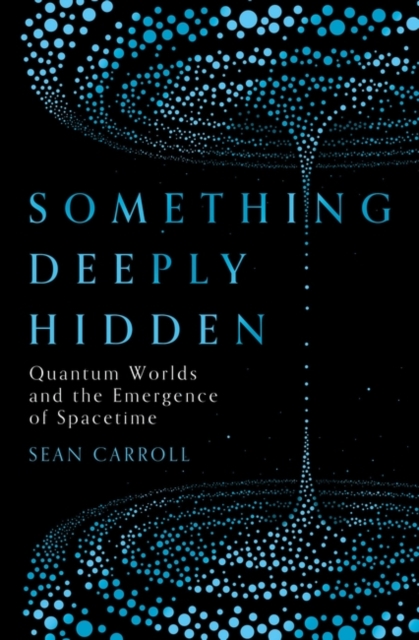Wave Functions, Woo and Westerns
Robin Ince's BlogWhen attempting to contemplate things at an atomic level, my brain collapses. Should I go subatomic, it reels wildly like a waltzer.

Before trying to comprehend quantum mechanics, my brain is in a superposition. There is EITHER the possibility that a lightbulb of enlightenment will glow above my head OR I leaf through pages and huff and howl and scowl like a Chimpanzee pondering a dung beetle. It is usually the latter. Perhaps my mind must always stall after the molecular level.
I have spent much of the week reading books about wave functions.
I started with What is Real by Adam Becker. He question the infamous “shut up and and calculate” position that is thrown about when talking of quantum physics. Mathematics is not enough, we must understand that the reality of quantum conjectures. He puts “shut up and calculate” into context. Physicist David Mermin actually said, “If I were forced to sum up in one sentence what the Copenhagen interpretation says to me, it would be shut up and calculate, but I won’t shut up.”
Becker also reveals that Niels Bohr enjoyed going to cowboy movies in his downtime. He would then sit with his friends in the cinema constantly bothering them with questions –
“Is that the woman who was married to the sheriff? Is he the man who shot the cowpoke? Is that the horse that reared up by the waterfall when the rattlesnake fell out of the lemon tree?”
(Ludwig Wittgenstein was also a fan of cowboy movies but, as far as we know, he sat and watched them in silence.)

Neils Bohr
Becker wants to know what quantum theory tell us about the nature of reality.
There is a divide in physics, between those that Becker sees as content to see quantum theory as a mathematical system that makes predictions and those that want to see how it creates and influences our world as a whole. Why should we be classical while an electron is quantum?
The Cosmic Shambles Network relies on your support on pledges via Patreon so we can continue to provide great, new, exciting content without the need for third party ads or paywalls.
For as little as $1 a month you can support what we do and get some great rewards for doing so as well. Click the Patreon logo to pledge or find out more.
“What does quantum physics tell us about the world? According to the Copenhagen interpretation, this question has a very simple answer: quantum physics tells us nothing whatsoever about the world.”
He also dispels the myth that Einstein just couldn’t quite hack the ramifications of quantum theory, fitting into the stereotype of the old scientist who can’t move on with the times (if times exist etc). Becker states that Einstein’s problem with the Copenhagen interpretation was that he didn’t think it was enough to have the mathematics without working out the ramifications for reality. Einstein considered that quantum physics “avoids reality and reason.” In a letter to Erwin Schrodinger he described Niels Bohr as “a talmudic philosopher [who] doesn’t give a hoot for ‘reality’ which he regards as a hobgoblin of the naive.”
Where is the divide between the classical Newtonian world and its laws and quantum mechanics?
Is it a boundary or a transition?

All this is also discussed by Sean Carroll in his latest book, Something Deeply Hidden. The search for a deeper understanding of quantum physics was frowned upon by many physicists, it was something that attracted philosophers more than physicists, much like the search for consciousness (another subject where quantum behaviour has been offered as a possible solution to why we are aware. The feuds between scientists may be caused by quantum behaviour of microtubules in the brain according to some reasonably unpopular theories of consciousness).
“Recently while writing a grant proposal, I was advised to concentrate on describing my work in gravitation and cosmology, which is considered legitimate, and remain silent about my work in the foundations of quantum mechanics, as that would make me appear less serious,” he writes in the prologue. Carroll’s interest in quantum mechanics is to find out how nature really works. He very clearly lays out the difference in the world under classical physics and the world as represented by quantum physics and the problems of understanding and lack of it that leads to. He states that Einstein’s failure was not in his understanding of quantum theory, but in his inability to persuade other physicists that the Copenhagen interpretation was inadequate. Carroll also counters the frequently quoted idea that an atom is predominantly empty space, rather than en electron in a specific space in the atom it is a wave function spread throughout it.
That’s a pity, I always liked that analogy of the atom as the dome of St Paul’s cathedral with a cricket ball as the nucleus and the electrons being flies buzzing around it.
Everything is quantum. Everything has a wave function. The universe is a wave function, and as I confront that, like Robocop attempting to arrest an Omnicorp employee, my brains starts to shut down. Carroll goes on to explore the possible ethical ramifications of Everettian many worlds theory, its lack of influence on the free will debate and how, despite the supposed possibilities used by science fiction writers, it shouldn’t cause you to change the way you live your life or dwell mournfully on how you ended up in the wrong Universe. I will be reading this book again in every Universe I find available to me (and Adam Becker’s too)
I have also enjoyed David Kaiser’s How the Hippies Saved Physics, an examination of how theoretical physics and mystic thinking brought quantum mechanics back into the spotlight in the 1970s.

They were particularly inspired by Bell’s Theorem that stated that faster than light signalling on a quantum scale is possible between particles that had once interacted. From this, some members of the Fysiks Group saw this as a symbol that we were indeed “all one” and, somewhere amongst all this counter-instinctual thought was found justification for telepathy, spoon bending and walking through walls. Those spooky actions from a distance got spookier and, for some, more profitable when conjuring trickery and sleight of hand illusion could be claimed to be mystical powers harbouring secrets of the laws of the universe.
This led to me pulling out my copy of The Dancing Wu Li Masters by Gary Zukav, a popular book of the late 70s about “ quantum mechanics, modern philosophy and eastern mysticism.”
David Kaiser states that Zukav’s book got a rough ride from the critics when it came out, with the New York Times saying that he was promoting the “dubious notions of renegade physicists”. Zukav then rewrote his book for the second printing, removing much of his reporting on the physics/consciousness movement. My copy is a first edition (UK) so I am not sure how intact it is. Nevertheless, it is critiqued throughout with marginalia from the reader. Under Zukav’s dedication, “this book is dedicated to you, who are drawn to read it” is written in pencil, “I was paid to read it. Maybe it wasn’t for me.” Pencil scars of sarcasm then make guest appearances throughout the book.
I end the week pleasantly confused. And to think, we are related to yeast, yet somewhere among the volcanic hellscapes, ice ages and cave doodling that led to this smoothish biped, a mind evolved that wasn’t satisfied with just being able to sort the poison fruit from the succulent sap and decided that after the blackberry course it would deal with quantum gravity. Well, that’s how it turned out in this world anyway.
Robin is at the British Library tomorrow with Book Shambles live with Josie Long and Les Dennis, then the Slapstick Festival the following weekend chatting with the likes of Stephen Merchant and The Goodies.
 Robin Ince is a multi-award winning comedian, writer and broadcaster. As well as spending decades as one the UK’s most respected stand-ups, Robin is perhaps best known for co-hosting The Infinite Monkey Cage radio show with Brian Cox. For his work on projects like Cosmic Shambles he was made an Honorary Doctor of Science by Royal Holloway, University of London. His latest book, I’m a Joke and So Are You is out now.
Robin Ince is a multi-award winning comedian, writer and broadcaster. As well as spending decades as one the UK’s most respected stand-ups, Robin is perhaps best known for co-hosting The Infinite Monkey Cage radio show with Brian Cox. For his work on projects like Cosmic Shambles he was made an Honorary Doctor of Science by Royal Holloway, University of London. His latest book, I’m a Joke and So Are You is out now.
If you would like to reuse this content please contact us for details
Subscribe to The Cosmic Shambles Network Mailing list here.
The Cosmic Shambles Network relies on your support on pledges via Patreon so we can continue to provide great, new, exciting content without the need for third party ads or paywalls.
For as little as $1 a month you can support what we do and get some great rewards for doing so as well. Click the Patreon logo to pledge or find out more.

